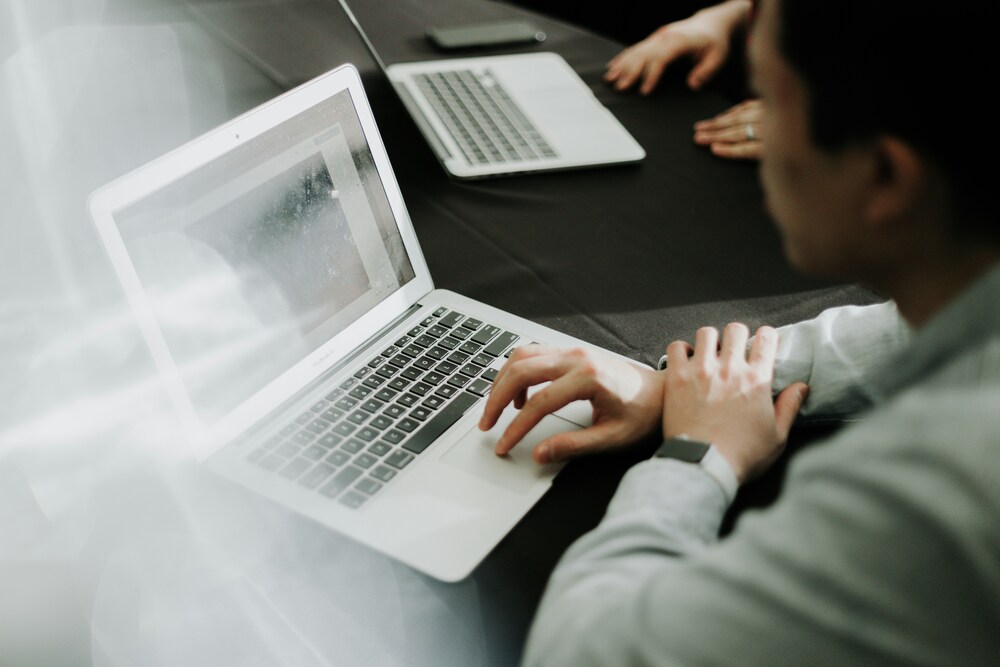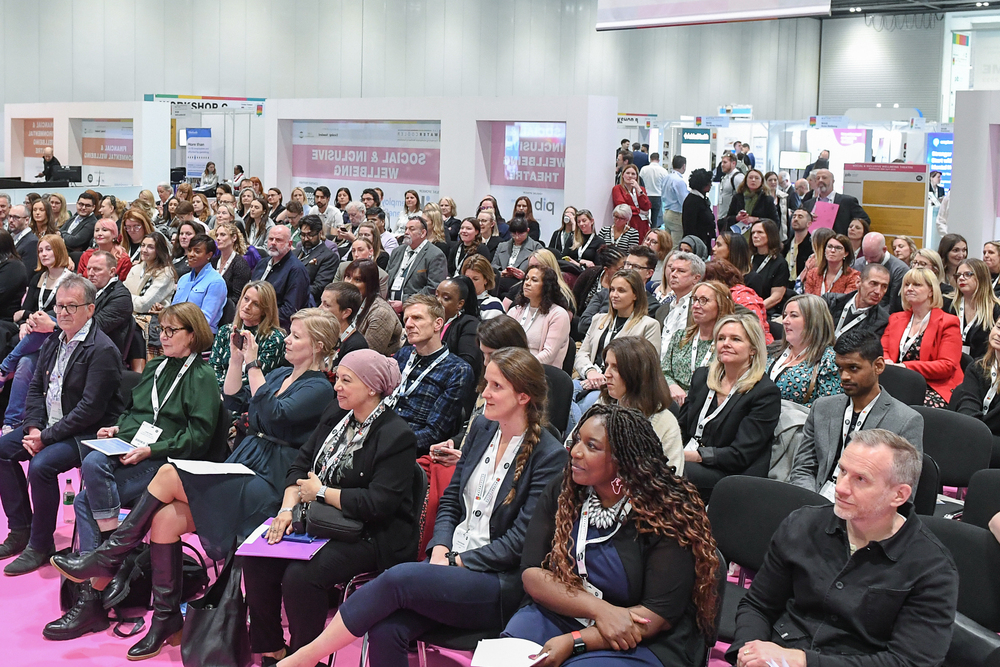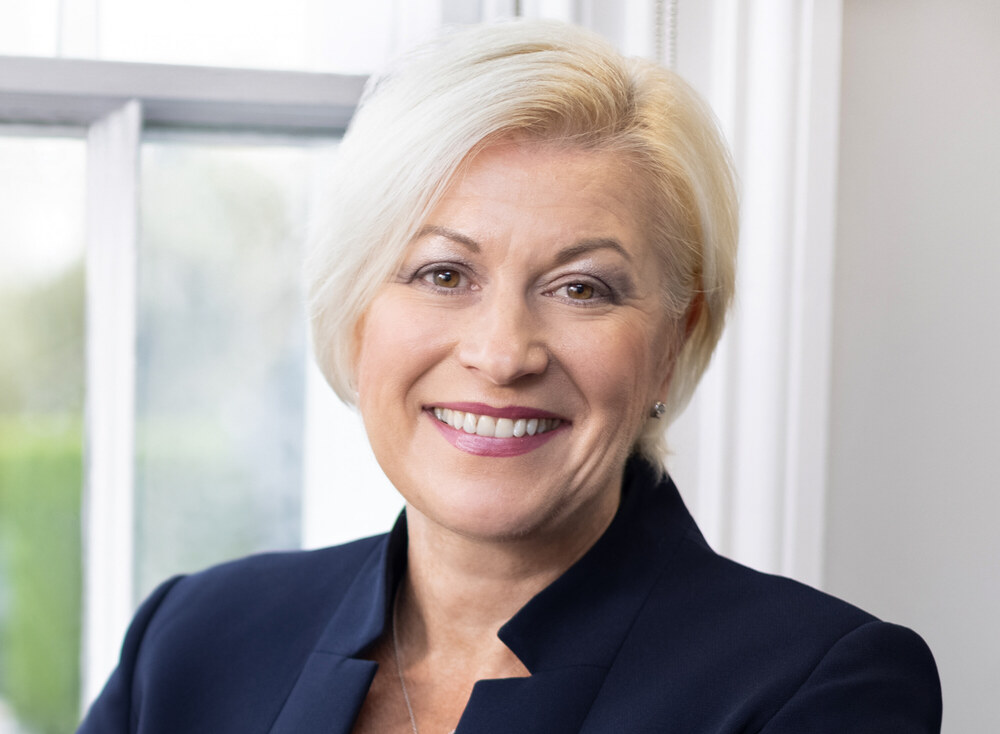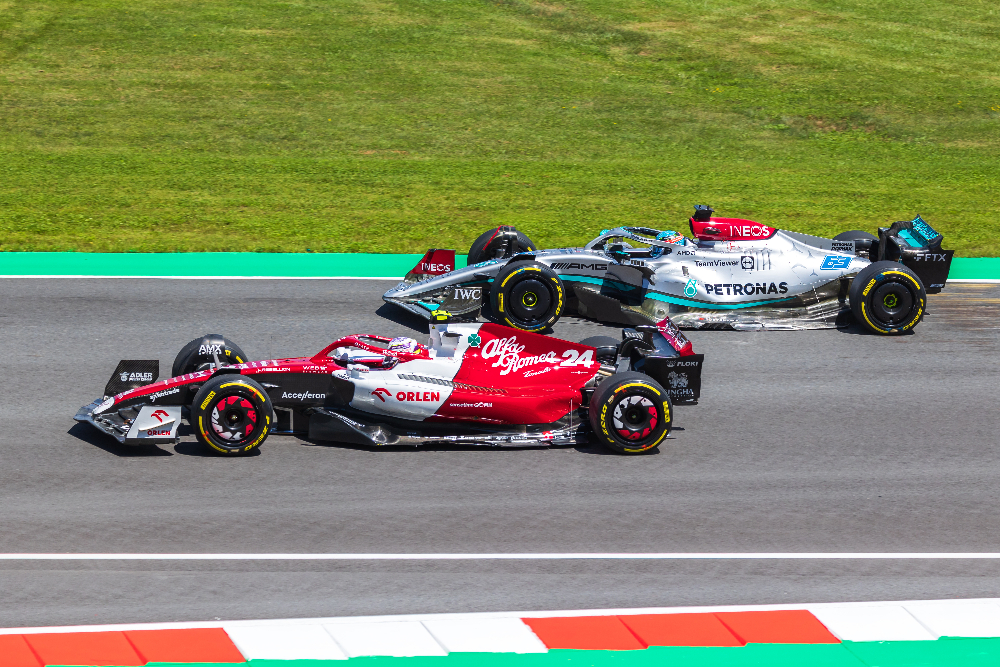How do we keep remote workers engaged and well? How do managers need to adapt their approaches? How do we recreate those all-important watercooler moments that spark creativity and collaboration? If these are challenges you’re facing, you’re not alone.
Since the pandemic hit in 2020, many employers have had to deal with a steep learning curve when it comes to home working. But others are lightyears ahead. Rather than trying to reinvent the wheel it makes sense to learn from those that have already implemented tried and tested approaches.
So, I was delighted when, as part of my research for the Make A Difference “Wellbeing in the New Hybrid World of Work” webinar, which is coming up on 24th March, I came across Shauna Moran and Gary Walker. Both are experts in remote working.
In this interview, exclusively for Make A Difference News, they share their wealth of experience and argue passionately that getting “remote first” right is the essential foundation for successful hybrid working.
First, please can you tell us a bit about yourselves and why your work is complementary (is one of you focused on the technology and the other on the mindset needed to make remote and hybrid working work?)
Shauna: We have complementary skills; As the founder of Operate Remote, I’m an accredited and award-winning transformational coach to founders, leaders and teams of fast-growing remote companies, a speaker, emotional intelligence practitioner and remote team researcher. I help remote organisations sustain their engagement, productivity and wellbeing so that they can focus on innovation and creating a successful business.
My mission is simple. To empower remote teams to develop self-awareness and sustainability practices to build emotionally-healthy and thriving organisations, for the long-term.
Gary: I’m a remote work specialist and digital director with over 20 years experience, not only working remotely, but building and nurturing remote teams. Following the success of Ready for Remote, the book which I co-authored three years ago, I created Ready for Remote to provide services to help organisations change the way they work for the better, providing people with greater flexibility and freedom.
I’ve helped organisations transform their ways of working by embedding digital and remote working practices, and increasing the adoption of digital tools. Thereby improving communication, productivity, wellbeing and work flexibility.
Lots of people are asking me how you create virtual watercooler moments. What would you suggest?
Gary: In a normal remote work setting (not during a pandemic), the social aspect of work may be more deliberate, but certainly not diminished. It is also important not to simply map what happens in a physical office location to a virtual setting. It is a chance to rethink this. Many organisations think that innovation is dependent on watercooler conversions. If this is true then it’s time to rethink this.
With careful consideration, you can create ways to facilitate people to have watercooler style social interactions. For example, most organisations use either Slack or Microsoft Teams as their digital collaboration platform. It’s a place where people communicate and collaborate.
Within these platforms, you can create channels as virtual places for people to interact more socially, and the advantage of this is it can happen asynchronously (ie. not occurring at the same time).
It is important to provide guidance for naming your channels. By giving channel names prefixes, you provide clarity on the purpose of each channel. For example, by using ‘Social-’ as a prefix, you could create multiple social channels such as; social-book club, social-film club, social-coffee chat.
Shauna: I think that most organisations are actually out-of-touch with what their teams actually want and need. The first question I’d suggest organisations ask themselves is ‘What is the objective of creating watercooler moments and is that something your team have said they need right now?’
70% of the workforce have experienced burnout (Monster, 2021) since the pandemic started so the LAST thing we want to do is to add more meetings to anyone’s calendar.
So depending on what your team want and need – and you should be collecting data on this on a frequent basis – depends on how you create those ‘watercooler moments.’
For example, a recent team I’ve worked with needed and wanted a better healthy lifestyle by working remotely. They decided that because so many people in their organisations felt passionate about this and were motivated to improve this, it would naturally be a great opportunity for relationship building – which was their objective for ‘watercooler’ moments.
The team now have weekly walking chats and a scoreboard that gamifies the challenge to make it fun. They also share and post walking pictures in their Slack channel and share tips and tricks for those have started to run. The evolution of these watercooler moments has come from the team itself, not the HR department and that’s what makes it meaningful. Just like Gary has said above, you can then use ‘social-physical health’ in Slack to create a community.
Do you need policies in place in order for remote and hybrid working to work for everyone? Or can this be left to individual managers to work out with their teams?
Gary: You must have policies in place for remote and hybrid working. This shouldn’t be left to individual managers to work out as this would create an inconsistent experience and cause friction.
There are several aspects to consider. Not only the construction of policies, but the creation of guidance, workflows and tools. You should also seek guidance with the transformation from a physical to virtual way of working through experienced remote work experts, not enthusiasts.
At Distribute (who deliver our Ready for Remote consultancy), one of the services we offer is resource creation. We’ve worked with some of the most reputable brands in the world to help them get ready for remote by helping them draft the policies and handbooks required for compliance and security.
Finally, you need to provide your people with training to equip them with the skills and knowledge required for virtual collaboration and asynchronous teamwork.
Shauna: I agree 100% with Gary here. No organisation is successful without policies and processes. There is of course a difference between having policies that have high usability and those that are created and forgotten about.
The secret? Involving your team in every step of the process of creation and implementation because then they feel apart of it, and thus, responsible for its success.
What are some of the best technologies/technical solutions that you’ve come across that can help to reduce the risk of burnout and improve communication, connection and collaboration when teams are working completely remotely or in a hybrid way?
Gary: Burnout (Wellbeing). Wellbeing is a topic close to my heart. For many of us the past year has been very challenging with *70% of employees reporting higher stress levels and *40% experiencing decreased mental health. (*Source: Microsoft Viva Insights Feb 2021)
There is an irony to the conversation about technology and burnout, as many people associate burnout with technology and an addiction to devices. However, there are many ways technology can help people reduce the risk of burnout.
To have sustained productivity, you need to disengage and replenish your energy, which is why disengagement is important to prevent burnout. By using tools correctly, you can help;
/ Protect your time
/ Reduce distractions
/ Focus on what is relevant to you
/ Reduce burnout
Since many organisations have adopted Microsoft Teams as their collaboration platform, let’s use that as one example of how a tool can help reduce burnout in a corporate setting. From April, Microsoft is introducing new and existing capability (named Viva Insights) into Microsoft Teams to help people focus on their wellbeing and productivity.
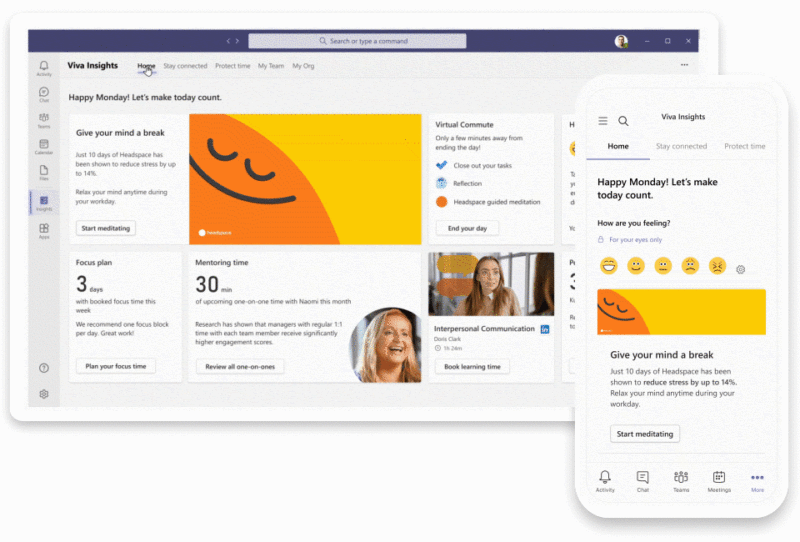
People will be able to access the ‘Insights’ icon on the left side rail. From there they can protect their time by using what is called ‘Focus Time’ to create space in their diary for deep focus work, or simply to protect it from becoming booked up. They’ll be able to use the new Headspace integration to access meditation or receive mindful moments throughout your day to encourage breaks and being present. Finally, they will be able to use emotional check-ins and track how they’re feeling.
There are other considerations on how to use Teams to support your wellbeing. By configuring your notification settings, you can reduce interruptions. And by using the ‘my activity’ icon you can reduce the anxiety of trying to keep up with the conveyor belt of information, and simply see what is relevant to you, or learn how to save items for later.
Aside from corporate tools, there are many personal tools that can support the reduction of burnout and improved wellbeing. We often work with clients to discuss wellbeing in tech and provide guidance for them on the best tools to use for the mind, body, and coaching.
Meditation is a great way to reduce feelings of anxiety and burnout. By using the Headspace meditation app for just 4 sessions it can reduce burnout by 14%. If you are willing to try it a little longer, 3 weeks of meditation has shown 21% more compassionate behavior, and cuts aggression & reactivity to negative feedback by 57%. (*Source: Headspace Report)
We’ve curated the best wellbeing tools on Ready for Remote and delivered Digital Wellbeing webinars to successfully help companies improve employee wellbeing, by providing insights and guidance on how to reduce burnout and increase focus..
Communication and Collaboration. There is an ever growing list of tools aimed at improving communication and collaboration. One of the first things you must consider is what digital collaboration platform you will use. We always recommend having a collaboration platform such as Slack or Teams as your digital workplace, and then using supplementary tools to enhance the employee experience.
A digital collaboration platform is the digital version of your office. It’s where people go to work, and you should look for the following features.
- Public spaces (Public Channels) for team and project collaboration, and private spaces (Direct Messages) for private conversation.
- You should be able to easily configure notifications settings to make it easy for you to mute any notifications that don’t mention you specifically. Notification curation is essential in a public channel set up to ensure that people don’t get overwhelmed by all the different conversations going on. By configuring notifications, you can also begin to build deeper focus time into your day.
- Video and/or voice messaging, either built-in or through an integration with a third-party tool.
- It is available as both desktop and mobile applications making it easier for your teammates to access shared documents or chats from either platform, without having to copy and paste content from one app to another.
All your team communication should happen here. You mustn’t fragment your conversation across multiple systems. Knowledge fragmentation impedes productivity, as people don’t know where to look to find the information they need to do their jobs.
It’s okay to use other project management tools to track project progress, but the digital collaboration platform is where all project-based and team conversations happen
It is crucial to note that the tool is not the goal, the tools have to go hand in hand with the culture shift. There will always be a tool to support the outcomes you want.
We’ve curated what we consider to be the best tools to get you started here: Ready for Remote Toolkit.
Shauna: As an emotional intelligence practitioner and award-winning coach, I know that what reduces and solves burnout challenges in remote teams is a blend of both processes AND mindset. We cover all of this and more in our Revive Remote Program – a program designed to help your team beat burnout, and create a fantastic remote culture that keeps them engaged and innovating.
Gary has covered tools extensively above, so I want to add from a mindset perspective and the best way to do that is to tell you a story. We can’t truly create a sustainable team if our team aren’t self-aware and our leadership team struggle to embrace flexibility
The most effective way to develop and adapt your culture on an organisational level is through developing your team and empowering them with knowledge, tools and the right mindset to not only make the change but to thrive in it.
Not solving these challenges limits the opportunities for your team to succeed in a hybrid environment, and teams become frustrated, fearful and disconnected. Most of the problems I see on teams start with the leaders. So, let me tell you the story of a client of mine who had 60% of his team burn out this year. (His identity will remain confidential, but we have permission to share this.)
Spoiler: you’re going to learn something very valuable at the end of this story.
This client approached me at a loss, he was not only losing projects and money, he was losing some of his best resources – his team. This stuff was keeping HIM awake at night. He tossed and turned over what he should and shouldn’t do. He wondered why the yoga workshops and the meditation classes he started on Zoom weren’t working.
Some of his team took stress leave. Those of his team that stayed working through this stress were making poor decisions, duplicating efforts and making mistakes. He couldn’t just pretend everything was OK anymore.
He had to face the facts and deal with this problem from the root, in order to put a stop to it once and for all. So he contacted me and we committed to resolving this issue. We worked together on a 1-1 coaching level to not only address but mitigate this massive risk within his team.
As an accredited coach who has worked with many founders experiencing the same challenges, I knew what conversations we needed to have first. We needed to first focus on him.
Quickly we discovered that he himself was burnt out. As a founder, his burnout approach was causing much of the tensions and stress within his team. He had gone so far away from his passion for starting a business that he didn’t even know WHY he was doing this anymore.
He valued things like family, freedom, growth, work-life balance and that’s why he decided to work for himself. And here he was, years later, not aligned to or living any of those values. He was living a life opposite to those values – stressed, overworked, overwhelmed, not having any time for himself or his beautiful family.
This issue had layers – all issues do, but we were successful in resolving them all.
Instead of focusing directly on the team, we worked on getting him back to a place where he was aligned to all of his values:
- We worked on his mindset to help him ‘let go’ of control and to trust his team
- We set healthy boundaries for him so he was able to prioritise and find meaning outside of his work
- We helped him improve his leadership communication skills so he could more effectively delegate and communicate his expectations
And when we worked on all of that, he no longer felt exhausted. Then he started to change his approach to his team. Because he was content and sustained on the inside, the external world around him started to change too.
He stopped messaging his team out of work hours because he switched off at a normal time in the evening. We created a new time management strategy that incorporated exercise and other activities that made him happy throughout the work week. His team had visibility into this – he was super transparent.
They witnessed him setting respectful boundaries with clients, partners and his team.
He hosted a town hall for his team and went through his new strategies, openly addressing burnout and sharing his findings and ways forward. His team started to follow suit and over time, burnout was no longer an issue.
We also have a free guide for anyone concerned about or experiencing burnout- https://operateremote.com/burnout
When operating a hybrid approach, how do you ensure people working from home don’t feel left out?
Gary: The key is a Remote-First Mindset. The rule: Even if only one person is remote, everyone should assume remote.
It seems strange at first to use a collaboration tool to talk to a colleague who you may be physically sitting next to, but it’s essential for creating transparency and clarity which is a fundamental principle of remote working.
Where does wellbeing fit into all of this? For context, at our 2019 in-person MADWorld event, Brendan Street from Nuffield Health ran a roundtable focused on how organisations can support mental health and resilience in remote and home workers. One insight shared was that the benefits derived can plateau if home working is undertaken for more than 2.5 days a week.
Gary: From my perspective, balance is the key. I wouldn’t agree that over 2.5 days working remotely per week is detrimental to your wellbeing.
I think a lot would depend on the level of guidance, support and training that companies provide you with. When working remotely, you quickly learn what works best for you. If new to remote working, you may go through a range of emotions and a guilt curve during the initial stages. However, by having flexibility to choose where to work from will provide you with the freedom to find the right balance for you.
For example, outside of a pandemic, I prefer to work from home, but I sometimes choose to walk to a local library, co-work space, or cafe to stimulate my senses and more interaction if required.
Shauna: Right now as workplaces we need to provide our teams with more flexibility to look after and tend to their mental health and wellbeing. Most organisations fail to do that because they are overworked and aren’t communicating effectively; they use meetings as opposed to asynchronous communication which kills flexibility.
No two individuals share the exact same challenges right now, some have kids at home, some live alone, some struggle with overworking, some find it a challenge to be focused. That’s why we need to give people the flexibility- so that they can make the best decisions for themselves each day, to not only show up in a productive way BUT to also do that in a sustainable and happy way.
Not only does flexibility solve the challenges around burnout but it also gives companies a distinct advantage. My clients find that from working with me, they are truly effective at remote work which enables them to be more innovative and creative. For example, not everyone wants to or is at their most productive early in the morning. One of my clients realised this early on when we worked together. Now they have automated communication asynchronously and people have the autonomy to choose when they work. They’ve also created employee profiles so that they know each other’s ‘working best practices’. So they’ll see when a colleague likes to have ‘deep work’ time away from notifications and calls, they’ll also see things like when a colleague prefers to take meetings and when they typically like to log off for the day. It takes time and some teams need more overlap than others but it works and your team will be happier.
7). Finally – I know people are also keen to understand how your work fits with employee experience and broader business transformation / change management agendas. Do you have anything to add on this, or is that a whole different conversation?
Gary: Our work goes hand in hand with employee experience and business transformation. The ways of working touches upon every part of the employee lifecycle, from pre-boarding through to exit/alumni.
Businesses should aim to adopt a product style development approach to their ways of working and employee experience. These should be a living thing, always evolving and improving.
Shauna: Our work is at the core of all three areas you mentioned- employee experience, business transformation and change management. We work for the long-term to empower these teams and businesses and the efforts that they put in pay off for the long-term, on so many levels.
_______________________________________________________________________________________________________________
Thank you Gary and Shauna for sharing your insights. For more ideas on supporting wellbeing in the hybrid world of work, register for our Make A Difference webinar here.
You might also be interested in these articles:







